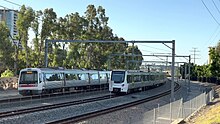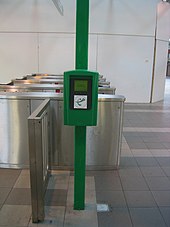| Transperth | |
|---|---|
 | |
From top left to bottom right: a B-series train on the Mandurah line, an A-series train on the Midland line, a Volvo B8RLE in Fremantle, MV Shelley Taylor-Smith | |
| Overview | |
| Owner | Public Transport Authority |
| Area served | Perth and surrounding areas |
| Transit type | Bus, ferry, rail |
| Number of lines | 7 (train)[a] |
| Number of stations | 76 (train)[b] 51 (bus)[c] |
| Annual ridership | 123,307,689 (year to June 2023) |
| Headquarters | Public Transport Centre |
| Website | Transperth |
| Operation | |
| Operator(s) | Captain Cook Cruises Path Transit Swan Transit Transdev WA Transperth Train Operations WAGR (former) MTT (former) |
| Number of vehicles | Over 1499 buses 330 railcars 3 ferries |
| Technical | |
| Track gauge | 1,067 mm (3 ft 6 in) narrow gauge |
| Electrification | 25 kV 50 Hz AC from overhead catenary |
Transperth is the public transport system for Perth and surrounding areas in Western Australia. It is managed by the Public Transport Authority (PTA), a state government organisation, and consists of train, bus and ferry services. Bus operations are contracted out to Swan Transit, Path Transit and Transdev. Ferry operations are contracted out to Captain Cook Cruises. Train operations are done by the PTA through their Transperth Train Operations division.
The Transperth train system consists of seven lines: the Airport, Armadale, Fremantle, Joondalup, Mandurah, Midland, and Thornlie lines; and 76 stations. Train services have operated since 1881. The Transperth bus system has over 1,499 buses and 51 bus stations, 38 of which are interchanges at railway stations. Buses have operated under private operators from 1903; these private operators were bought out by the Metropolitan Transport Trust starting in 1958. Contracting out the bus operations began in the mid-1990s. The Transperth ferry system has one route, two stops, and three ferries. The system extends as far north as Two Rocks on the outer north of the Perth metropolitan area, Wundowie in the Shire of Northam, and Dawesville in the south of Mandurah. Fares are paid using the SmartRider system or using cash. With 123,307,689 boardings in the year to June 2023, Transperth has the fourth highest patronage in Australia, although the train system has Australia's third highest train patronage.






